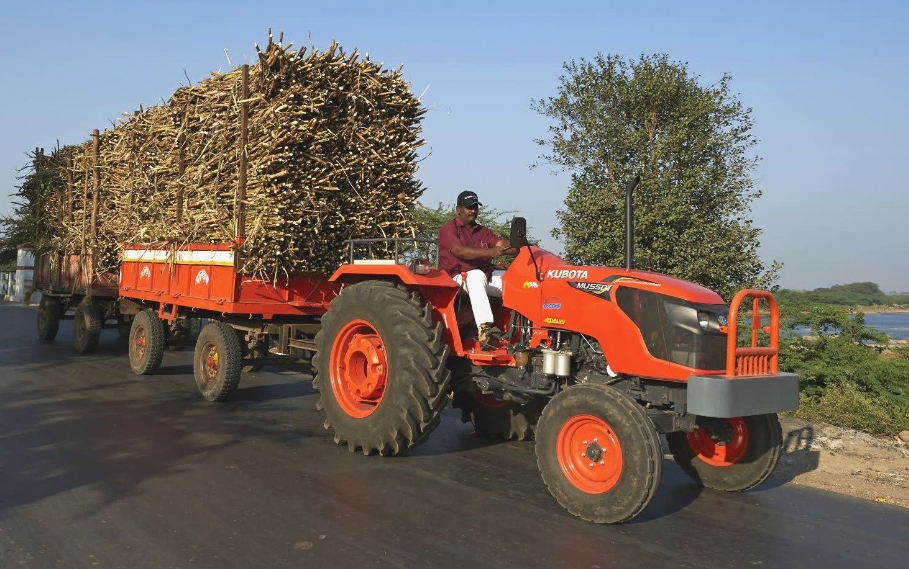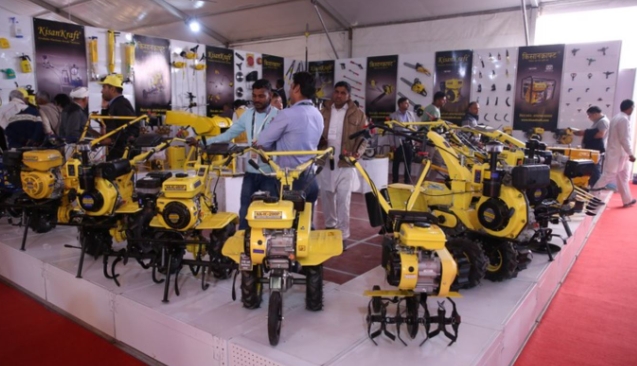One month after the end of the Indian EIMA Agrimach exhibition, we spoke with the President of FederUnacoma. Meanwhile, the Indian subcontinent is confirmed as an area of great interest for agricultural mechanization thanks to a market that is unrivaled in terms of units sold. Today the question is about unsophisticated equipment, but in the future….
India of engineers and new technologies has its counterpart in rural India, an important country that produces 314 million tons of cereals and 334 million tons of fruit and vegetables (to give an idea it produces about 93.5 million of tons of wheat, Italy 8). Great potential and an important market for Italian companies which, also in other sectors, are always looking for new opportunities, especially in this period in which important countries are closed for geopolitical reasons, like the war in Ukraine.
On the occasion of the 7th edition of EIMA Agrimach, Shobha Karandlaje, Union Minister of State for Agriculture and Farmers’ Welfare in Bangalore highlighted how Indian farmers need machinery to improve productivity and the added value of their production. and reliable, low-cost technologies. A challenge and an opportunity for the Italian companies that this year presented themselves in Bangalore for this restart destined to blossom definitively in December 2023. Regarding the Indian appointment and the next developments, we asked a few questions to the President of FederUnacoma Alessandro Malavolti.
How did EIMA Agrimach India go and what are the prospects for the Fair and the Indian market?
The Indian exhibition went very well, because we had over 10 thousand visitors, an important result also considering that this was the first edition in Bangalore, in the state of Karnataka, after the six editions held in New Delhi, and that in early September they are a time of the year still affected by monsoons and therefore not optimal for logistics and transport. From 2023 we will return with the traditional location of December and we will have the wealth of experience already gained in the new exhibition structure in Bangalore. After this ‘preview’ in September, the show will therefore be back in full swing and I believe it will have excellent results.
We have seen a boom in sales of tractors in India, but from a qualitative point of view what is the state of the art of the market and which are the most interesting sectors?
India has established itself in recent years as the first market in the world in terms of units sold. In 2021 it reached the impressive share of one million units, after a few years in which it stood at volumes close to 800,000, i.e. double the Chinese market and almost three times that of the US. The success of the tractors is also linked to the fact that they represent, in the enormous territories of the Subcontinent, a multipurpose vehicle, useful for transport of all kinds and therefore widely used. With regard to the demand for agricultural machinery, it should be considered that Indian agriculture is structured with small farms, with average areas of less than one hectare. This entails a request for unsophisticated technologies, but nevertheless efficient and, in the future, increasingly refined and performing.
What are the technological innovations in which the Indian market has found the most interest? And what were the most relevant innovations presented at Agrimach or the most original products?
The tractor market is proceeding at a great pace, and yet the mechanization process of Indian agriculture requires a much wider range of technologies: soil tillage equipment, harvesting and sowing machines, fertilization systems and means for the transport of products. Farming technologies are becoming increasingly important, but there is also interest in energy conversion systems for agricultural biomass, capable of meeting the needs of companies and rural communities. The Agrimach fair’s mission is precisely to present the wide range of technologies and product innovations designed for the Indian market. New Holland, for example, has chosen Agrimach 2022 to launch its new tractor model designed for the local market.

We know that the Indian market is very strong from a software point of view, do you think there are opportunities for technological joint ventures of some kind between Italian and Indian companies? Or what further kind of collaboration / development do you see?
Electronics applied to agricultural machinery is a phenomenon that is exploding worldwide, if we think that by 2026 the value of digital systems for agriculture will have almost tripled to over 34 billion dollars. The process of digitization of agriculture is more marked in technologically advanced countries, but it is also destined to affect India where these technologies are not yet a priority for the agricultural system. Nevertheless, this country has its own tradition in electronics, and aims, for example, with the use of specialized control units, to optimize those irrigation and fertilization operations that in modern agriculture require an increasingly rational and scientific management. Also in this area it is possible that synergies will develop between Italian and Indian industries.
From the point of view of the robots, did you see anything particular?
Robotics has a strategic value in all those countries in which agriculture is highly “industrialized”, and in which there is a need to make up for the lack of manpower with highly automated technologies. For a country like India, which has a strong agricultural connotation, and which has an overabundant manpower, robotics does not represent a mature prospect and does not constitute, at the present time, a market on which Indian and foreign manufacturers present in the country have an interest in investing.
What feedback did you receive from the 15 Italian companies that took part in Agrimach? Do you think that the present team could increase in the coming years and which sectors have been under-represented or would it be worthwhile to involve?
Positive feedback. The Italian companies that participated – directly or through their distribution and import structures and their production and commercial branches – had numerous contacts with local operators, and confirmed the perception of India as a non-growing market. only for tractors, as mentioned, but for all types of machines. Positive feedback has come about the new location of the exhibition, since Bangalore represents the heart of those vast southern regions where specialized crops have developed, see in particular fruit and vegetables. Where agriculture focuses on products with higher added value, entrepreneurs are led to make technological investments to be more competitive.

Arriving at Eima, did you take home any ideas that can further enhance the Bolognese event? What should we expect?
The most useful result for Eima’s purposes is the strengthening of technical and commercial cooperation with India. To date we have already confirmed 25 Indian manufacturers who will exhibit at the great event in Bologna, while we await numerous economic operators from the country. It should not be overlooked that EIMA 2022 takes place at a time of great development in business relations between India and Italy. Last year, global trade between the two countries rose to 10 billion, marking an all-time record, and in the first half of this year there was a further growth of 25%. As regards agricultural machinery in particular, in 2021 the value of Italian exports to India grew by 33%, and by a further 29% in the first five months of this year. The Indian presence at EIMA is the important piece of an event that has an ever wider international dimension, a lively and highly technical event that represents for all operators, as this year’s claim says, a global experience.
